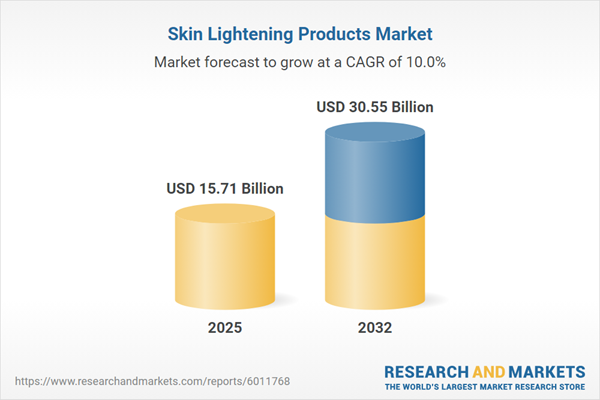Speak directly to the analyst to clarify any post sales queries you may have.
The skin lightening products market is experiencing notable shifts, presenting new challenges and opportunities for executive teams. Increasing regulatory developments, changing consumer values, and expanding digital engagement are compelling leaders to adapt rapidly to ensure ongoing growth and market relevance.
Market Snapshot: Skin Lightening Products Market Size and Growth
The global skin lightening products market is demonstrating robust expansion, with market value expected to increase from USD 14.25 billion in 2024 to USD 15.71 billion in 2025, and reaching an estimated USD 30.55 billion by 2032. This growth reflects a compound annual growth rate (CAGR) of 10%. Momentum is underpinned by persistent interest in individualized care, pivots in regulatory frameworks, and ongoing innovation across product lines. The accelerated shift to digital platforms has altered how stakeholders interact and how products reach customers, expanding consumer access and enhancing transparency throughout the value chain. Organizations are heightening focus on compliance and optimizing their operational models to ensure supply chain resilience in international markets.
Scope & Segmentation: Strategic Overview
This report delivers executive-focused intelligence for global decisions, dissecting market segments, adoption of advanced technologies, and strategies tailored to diverse stakeholders. Leaders will gain clear perspective on dynamic consumer trends and the shifting regulatory environment, enhanced with granular insights across all relevant segments:
- Product Type: Comprehensive review of creams, gels, lotions, and serums, with a focus on personalized and routine-integrated skincare approaches.
- Distribution Channel: Assessment of online retail, pharmacy, specialty, and supermarket channels, enabling development of integrated omnichannel models and expanded consumer connection points.
- Ingredient: Analysis covers arbutin, hydroquinone, kojic acid, and botanical alternatives, highlighting industry efforts toward ingredient safety and global regulatory standards.
- Application: Examination of body gels, lotions, day and night creams, and sheet masks, reflecting increased interest in bespoke, routine-centric solutions.
- End-User: Insight into male, female, and unisex formulations empowers inclusive product development and versatile positioning.
- Price Range: Review covers mass-market, value, and premium offerings, informing segmentation strategies based on differing purchasing power across regions.
- Product Form: Reporting on emulsion, liquid, ointment, and powder innovations evidences how form factor impacts user preference and product engagement.
- Regions: Regional coverage includes the Americas, Europe, Middle East and Africa, and Asia-Pacific, with attention to regulatory nuances and unique market drivers.
- Key Players: Profiles of L’Oréal S.A., Unilever PLC, Procter & Gamble, Shiseido Company, Beiersdorf AG, Johnson & Johnson, Kao Corporation, Amorepacific Corporation, Estée Lauder Companies, and Coty Inc. support strategic benchmarking and enable thorough evaluation by decision-makers.
Key Takeaways for Strategic Leadership
- Emphasizing plant-based and multi-functional product development supports alignment with consumer safety and adaptability requirements.
- Digital transformation promotes streamlined processes and strengthens both B2B and B2C engagement, enhancing market position.
- Transparency and ethical conduct in the supply chain advance brand credibility and have positive effects on buyer actions in diverse regions.
- Physical retail remains significant for delivering tailored service and maintaining customer loyalty, complementing digital sales channels.
- Employing data-driven marketing and expanding product variety enables companies to meet fast-changing consumer and regulatory demands.
- Investment in advanced active ingredients and new delivery formats fosters product differentiation, especially within high-value and premium segments.
Tariff Impact on Market Strategies
Changes to U.S. cosmetics import tariffs prompt organizations to reexamine sourcing and logistical frameworks. Regional supply chain development, greater domestic manufacturing, and adoption of bonded warehousing are helping firms manage costs and address rising consumer preference for locally produced premium goods.
Methodology & Data Sources
Market analysis is based on comprehensive desk research, quantitative surveys, and specialist contributions in dermatology and supply chain management. All insights are validated using sector reports, regulatory documents, and peer-reviewed research to ensure reliability and executive relevance.
Why This Report Matters
- Empowers senior teams to respond rapidly to shifting market segments and regulatory environments with tailored analysis.
- Equips executives with data-led strategies to identify, assess, and manage operational and tariff risk efficiently.
- Supports planning for go-to-market success, market entry, and sustained positioning by providing actionable competitive and regional insights.
Conclusion
Success in the skin lightening products market requires leaders to champion innovation, maintain robust compliance, and ensure supply chain flexibility. This report provides actionable intelligence to support effective decision-making and strategic market growth.
Additional Product Information:
- Purchase of this report includes 1 year online access with quarterly updates.
- This report can be updated on request. Please contact our Customer Experience team using the Ask a Question widget on our website.
Table of Contents
3. Executive Summary
4. Market Overview
7. Cumulative Impact of Artificial Intelligence 2025
Companies Mentioned
The companies profiled in this Skin Lightening Products market report include:- L'Oréal S.A.
- Unilever PLC
- The Procter & Gamble Company
- Shiseido Company, Limited
- Beiersdorf AG
- Johnson & Johnson
- Kao Corporation
- Amorepacific Corporation
- Estée Lauder Companies Inc.
- Coty Inc.
Table Information
| Report Attribute | Details |
|---|---|
| No. of Pages | 195 |
| Published | October 2025 |
| Forecast Period | 2025 - 2032 |
| Estimated Market Value ( USD | $ 15.71 Billion |
| Forecasted Market Value ( USD | $ 30.55 Billion |
| Compound Annual Growth Rate | 10.0% |
| Regions Covered | Global |
| No. of Companies Mentioned | 11 |









